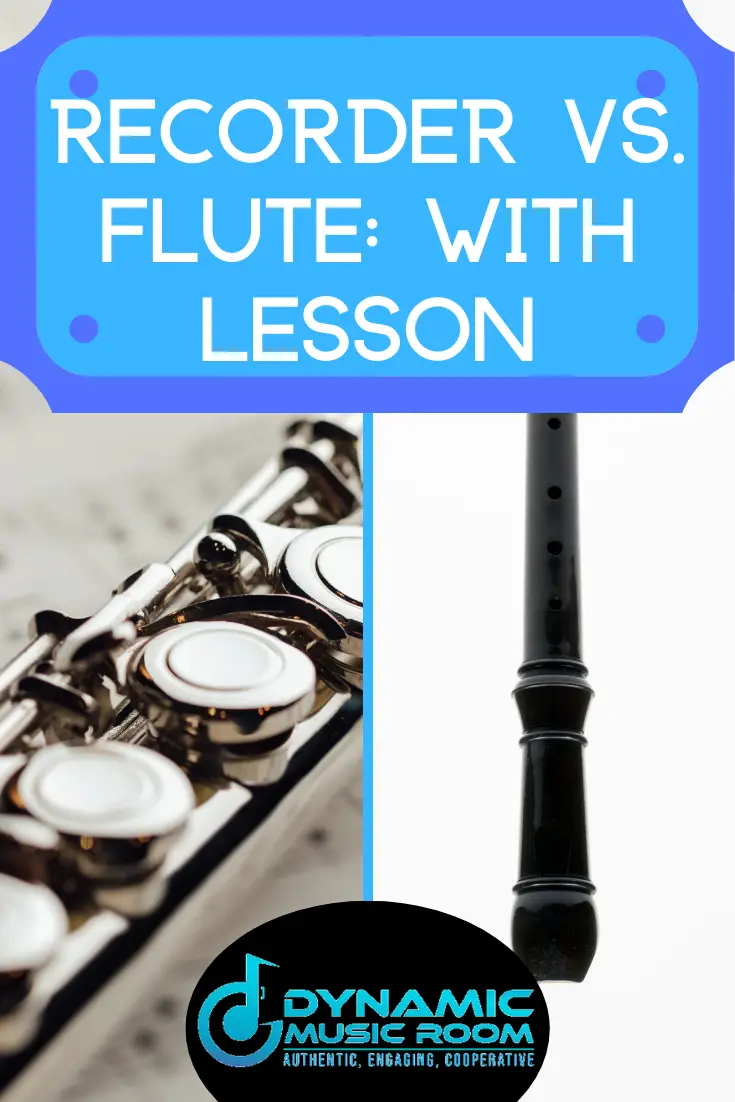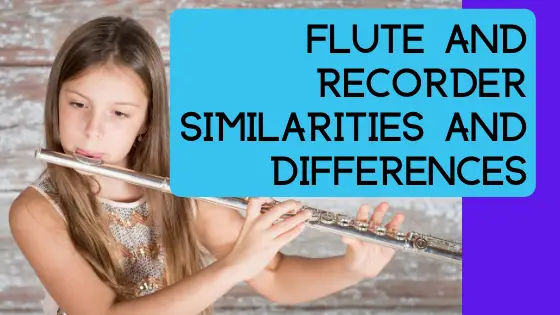Are you looking for ways to elevate your music teaching by comparing flute and recorder?
Do you want to learn more about the difference between the two?
One of the most effective teaching strategies for any content area is to encourage higher-level thinking through comparing and contrasting two different things. In fact, compare and contrast is one of the tasks which helps to develop intelligent thinking (ASCD.org).
For music, one of the ways I love doing this is by looking at flute and recorder similarities and differences.
Flute and recorder are members of the same family and produce sound in a similar manner, namely through the splitting of air which, in turn, creates vibration at specific pitches. They also alter the pitches on their instrument by covering different holes on their instrument (even some of the fingering patterns are similar).
Look ahead for more similarities and differences as well as a lesson plan for students to encourage comparative thinking.
Note: For this article, I’ll be comparing the flute to the soprano recorder.
Table of Contents
Flute And Recorder Similarities
In this section, we’ll look specifically at the similarities between the two instruments. Since they’re in the same specific sub-family, don’t be surprised how much of the two instruments are the same.
Learn more about what a soprano recorder is.
Sound Creation
The biggest way they are the same is how they make their sound.
It’s not exactly the same, but the idea is the same.
The whole process is complicated and scientific, but here it is in simple terms (this is how I usually explain it to kids and adults with not a lot of musical background).
When you blow into a recorder, there is a small wedge in the mouthpiece. As the air hits the wedge, it splits the air with some going out the window (rectangular hole) and some continuing down the recorder.
This splitting causes a vibration in the air going both in and out of the hole. It’s this vibration that causes the sound.
The flute functions largely the same.
As you blow air across the tone hole on the hole, it hits the back part of the tone hole. When it does, it’s split with some air continuing forward while some travels down the flute.
This splitting causes vibration in both columns of air. Similar to blowing across a pop bottle.
The direction and mechanism are slightly different, but the process is the same.
Fingering
Surprisingly, fingering on flute and recorder are almost exactly the same.
Yes, the flute uses keys, but the order of the fingers correspond to the same notes.
The first note you learn which pushes down the first hole is B. From there, as you add fingers, you get A and G.
The rest is shockingly similar as well.
Many of my students who play flute have a head start over the other instruments due to this similarity.
This makes sense given its history…
History
Both flutes and recorders come down from the same ancestry of instruments. Whistle-like and flute-like instruments have been found throughout all of human history.
They all share common elements:
- Wedge/Splitting of air to create sound
- Holes to cover to change the pitches
In fact, our modern flute (called the transverse flute) is a direct descendant of the recorder which rose to popularity in the Renaissance and Baroque periods (check out the difference between Baroque and German recorders).
Tone
The airy, clear tone of the instruments is similar.
The main differences between the two come from the material and not design.
Related Reading: You may also want to check out alto vs. soprano recorder.

Recorder Vs. Flute: The Differences
This section deals specifically with the difference between the two. As you read, you’ll notice the flute is just a more mature instrument with more player control.
Position
The easiest difference is how each instrument is held.
The recorder is traditionally held facing forward, while the flute is held transverse or sideways.
This is where the flute gets its full name, transverse flute.
Tone
Tone is similar, but it’s also different.
The metal of the flute allows for more complexities in tone and more depth.
A recorder’s traditional wood or plastic material is more simple in its sound, though high-quality recorders do a good job of making a rich sound as well.
Because the flute doesn’t use a wedge to split the air, the player has more control over how they blow to create different tone quality or timbre.
Incidentally, this also makes the flute much harder to pick up and play compared to the recorder.
Dynamic Control
Dynamic control is one of the big reasons the flute took over the recorder’s place in the orchestras of the Baroque period. By the Romantic, the flute was cemented as the instrument of choice.
The recorder, even with a high-quality design is generally described as a soft instrument. Good players can get louds and softs, but the overall range is much quieter compared to the flute.
Plastic recorders do have a reputation for being loud, but in reality, they’re not loud, they’re just squeaky.
As the ensembles of the day got larger, the recorder kept getting drowned out. The flute stepped in to cover the same parts with more punch and power.
Overall Range Of Pitches
Between the transverse design and more holes present on the flute, it has access to a lot more pitches overall than the recorder.
The recorder may play all the pitches in a general 2-octave range, while the flute plays all pitches in a general 3-octave range.
Pitch Placement
Pitch placement is different (remember, compared to the soprano recorder).
A standard flute starts an octave lower than the recorder.
Size
Size is also a difference.
The transverse flute is usually around 26 inches. A soprano recorder is around 12 inches long.
How Holes Are Covered
With your hands sideways, a greater length, and more holes, the flute needs help covering the holes.
It uses keys to press down felt pads to cover the holes.
The soprano recorder is short enough for all fingers to reach easily, so all you use is your fingers to cover the holes.
Note: The tenor, bass, and larger recorders will also begin to use keys to help the player reach the holes.
Lesson Plan For Recorder Vs. Flute Comparative Thinking
I mentioned before how educational experts consider compare and contrast to be one of the easiest and best ways to spark intelligent thought.
Still, if you’re not sure where to start, I’ll give you what I do.
Compare And Contrast
Grade: 3rd-5th Grade
Musical Concept: Instrument families, how sound is made
Grouping: 4, teacher-selected
Goal: Compare and contrast the flute and recorder with at least 3 similarities and 5 differences. Create a Venn diagram. Present to the teacher or class.
Accountability:
- Group: Create a Venn diagram and present it to the teacher or class.
- Individual: Students are limited to 2 chips and each chip counts as the initial idea towards the diagram.
Materials: Blank Venn diagram, 2 talking chips per student, a flute and recorder is person to look at, recordings of both playing, pictures of each for closer study
Expectations:
- When a student starts an idea, they place a chip down
- When a student is out of chips, they can’t start an idea
- Students will not make fun of others’ ideas
- Groups will raise their hand to ask a question and/or settle a dispute
- Only one person will speak at a time
- When the teacher attention signal is heard, all activity and talking will stop right where it is
Social Prompts:
When ideas are shared:
Your idea was fascinating! It takes a lot of courage to share a personal idea.
When a critique is offered:
I see what you’re saying, but I don’t agree. Maybe think about it like this…
When critique is heard:
Thanks for your input! It shows you care. I like it; let’s change it (OR) Your idea is good, but I like it the way it is.
Procedure Explanation:
1. Getting Set
Teacher picks the groups of 4 and spreads the groups around the room.
The teacher explains how the chips work. When a student starts an idea, they spend a chip.
When the chips are gone, this student can’t start any ideas, though they may discuss with the group others’ ideas and help out.
Review quiet signals and expectations.
Model compare and contrast as well as the social cues.
The teacher should circulate and observe how well the groups are working. Offer probing questions and give specific feedback.
Towards the end, self-check the groups or have them share with the class.
Check out my guide to cooperative learning in music for more ideas on what to do and how to encourage kids to work together effectively.
Final Thoughts
Now you know more about the flute and recorder similarities as well as how to teach recorder vs. flute with comparative thinking.
These lessons ideas can and should be applied to other parts of your instruction as well. Sometimes we get so caught up in the musical aspects of our job, we forget to also encourage and connect higher-order thinking skills.
Looking for some recorder sheet music? Check out our recorder songs page for our free options.
If you don’t find what you want, head over to Sheet Music Plus and look at their massive selection of notation including recorder music.

